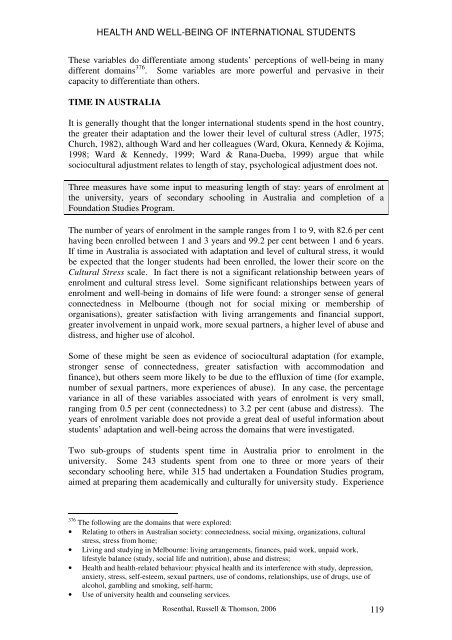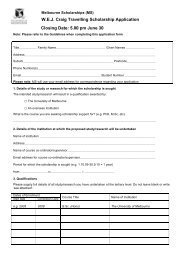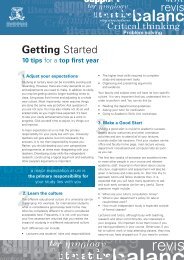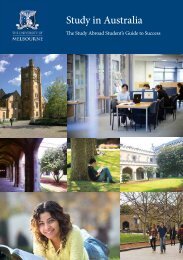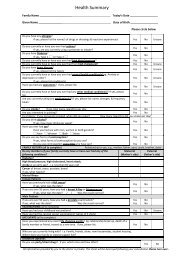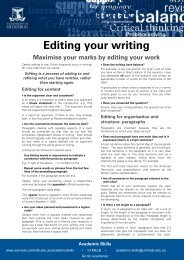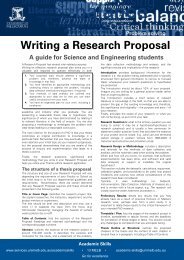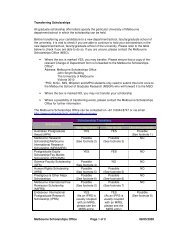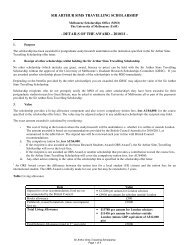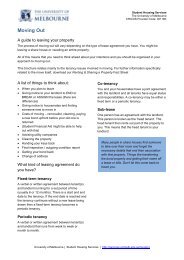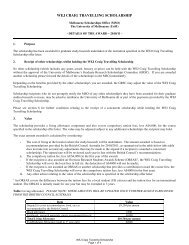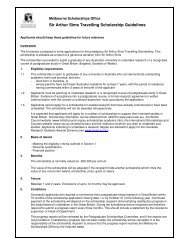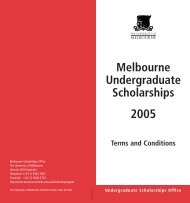a growing experience - Student Services - University of Melbourne
a growing experience - Student Services - University of Melbourne
a growing experience - Student Services - University of Melbourne
You also want an ePaper? Increase the reach of your titles
YUMPU automatically turns print PDFs into web optimized ePapers that Google loves.
HEALTH AND WELL-BEING OF INTERNATIONAL STUDENTSThese variables do differentiate among students’ perceptions <strong>of</strong> well-being in manydifferent domains 376 . Some variables are more powerful and pervasive in theircapacity to differentiate than others.TIME IN AUSTRALIAIt is generally thought that the longer international students spend in the host country,the greater their adaptation and the lower their level <strong>of</strong> cultural stress (Adler, 1975;Church, 1982), although Ward and her colleagues (Ward, Okura, Kennedy & Kojima,1998; Ward & Kennedy, 1999; Ward & Rana-Dueba, 1999) argue that whilesociocultural adjustment relates to length <strong>of</strong> stay, psychological adjustment does not.Three measures have some input to measuring length <strong>of</strong> stay: years <strong>of</strong> enrolment atthe university, years <strong>of</strong> secondary schooling in Australia and completion <strong>of</strong> aFoundation Studies Program.The number <strong>of</strong> years <strong>of</strong> enrolment in the sample ranges from 1 to 9, with 82.6 per centhaving been enrolled between 1 and 3 years and 99.2 per cent between 1 and 6 years.If time in Australia is associated with adaptation and level <strong>of</strong> cultural stress, it wouldbe expected that the longer students had been enrolled, the lower their score on theCultural Stress scale. In fact there is not a significant relationship between years <strong>of</strong>enrolment and cultural stress level. Some significant relationships between years <strong>of</strong>enrolment and well-being in domains <strong>of</strong> life were found: a stronger sense <strong>of</strong> generalconnectedness in <strong>Melbourne</strong> (though not for social mixing or membership <strong>of</strong>organisations), greater satisfaction with living arrangements and financial support,greater involvement in unpaid work, more sexual partners, a higher level <strong>of</strong> abuse anddistress, and higher use <strong>of</strong> alcohol.Some <strong>of</strong> these might be seen as evidence <strong>of</strong> sociocultural adaptation (for example,stronger sense <strong>of</strong> connectedness, greater satisfaction with accommodation andfinance), but others seem more likely to be due to the effluxion <strong>of</strong> time (for example,number <strong>of</strong> sexual partners, more <strong>experience</strong>s <strong>of</strong> abuse). In any case, the percentagevariance in all <strong>of</strong> these variables associated with years <strong>of</strong> enrolment is very small,ranging from 0.5 per cent (connectedness) to 3.2 per cent (abuse and distress). Theyears <strong>of</strong> enrolment variable does not provide a great deal <strong>of</strong> useful information aboutstudents’ adaptation and well-being across the domains that were investigated.Two sub-groups <strong>of</strong> students spent time in Australia prior to enrolment in theuniversity. Some 243 students spent from one to three or more years <strong>of</strong> theirsecondary schooling here, while 315 had undertaken a Foundation Studies program,aimed at preparing them academically and culturally for university study. Experience376 The following are the domains that were explored:• Relating to others in Australian society: connectedness, social mixing, organizations, culturalstress, stress from home;• Living and studying in <strong>Melbourne</strong>: living arrangements, finances, paid work, unpaid work,lifestyle balance (study, social life and nutrition), abuse and distress;• Health and health-related behaviour: physical health and its interference with study, depression,anxiety, stress, self-esteem, sexual partners, use <strong>of</strong> condoms, relationships, use <strong>of</strong> drugs, use <strong>of</strong>alcohol, gambling and smoking, self-harm;• Use <strong>of</strong> university health and counseling services.Rosenthal, Russell & Thomson, 2006 119


